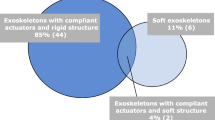Abstract
Nowadays, enhancing the physical abilities of able-bodied humans attracted the researchers’ attention besides the development of assistive devices for people with mobility disorders. As a result, the interest in designing of cheap and soft wearable exoskeletons called exosuits is distinctly growing. Careful investigation of the biological musculoskeletal systems reveals three essential features simplifying gait control. The first property is the embedded compliance in the muscle-tendon-complex (MTC). Force-velocity or damper-like muscle behavior is the second feature. The last useful feature is in the biological morphological design of multi-articular muscles. These properties can be implemented in passive, assistive devices in isolation or combination. In this paper, we summarize a few studies on passive lower limb assistive devices that benefit from these two design concepts. We elaborate more on the outcomes of a recent study on a lower limb exosuit design with two biarticular elastic elements that combine the two aforementioned mechanisms in a single device.
This article is partially supported by the German Research Foundation (DFG) under the Grant No. AH307/2-1.
Access this chapter
Tax calculation will be finalised at checkout
Purchases are for personal use only
Similar content being viewed by others
References
Apparatus for facilitating walking, running, and jumping
H. Barazesh, M.A. Sharbafi, A biarticular passive exosuit to support balance control can reduce metabolic cost of walking. Bioinspiration & Biomimetics 15(3), 036009 (2020)
S.H. Collins, M. Bruce Wiggin, G.S. Sawicki, Reducing the energy cost of human walking using an unpowered exoskeleton. Nature 522(7555), 212 (2015)
A.J. Van Soest, A.L. Schwab, M.F. Bobbert, G.J. van Ingen Schenau, The influence of the biarticularity of the gastrocnemius muscle on vertical-jumping achievement. J. Biomech. 26(1), 1–8 (1993)
M.A. Sharbafi, C. Rode, S. Kurowski, D. Scholz, R. Möckel, K. Radkhah, G. Zhao, A.M. Rashty, Oskar von Stryk, A. Seyfarth, A new biarticular actuator design facilitates control of leg function in biobiped3. Bioinspiration & biomimetics 11(4), 046003 (2016)
A.J. Van den Bogert, Exotendons for assistance of human locomotion. Biomed. Eng. Online 2(1), 17 (2003)
S. Portnoy, A. Kristal, A. Gefen, I. Siev-Ner, Outdoor dynamic subject-specific evaluation of internal stresses in the residual limb: hydraulic energy-stored prosthetic foot compared to conventional energy-stored prosthetic feet. Gait & Posture 35(1), 121–125 (2012)
A. Naseri, M.M. Moghaddam, M. Gharini, M.A. Sharbafi, A novel adjustable damper design for hybrid passive ankle prosthesis. Actuators (2020)
M.C. Faustini, R.R. Neptune, R.H. Crawford, S.J. Stanhope, Manufacture of passive dynamic ankle-foot orthoses using selective laser sintering. IEEE Trans. Biomed. Eng. 55(2), 784–790 (2008)
M.M. Alemi, S. Madinei, S. Kim, D. Srinivasan, M.A. Nussbaum, Effects of two passive back-support exoskeletons on muscle activity, energy expenditure, and subjective assessments during repetitive lifting. Hum. Factors 62(3), 458–474 (2020)
B.F. Palmer, Artificial leg. US Patent (1846)
W. Van Dijk, H. Van der Kooij, E. Hekman, A passive exoskeleton with artificial tendons: design and experimental evaluation, in 2011 IEEE International Conference on Rehabilitation Robotics (IEEE, New York, 2011), pp. 1–6
R. Nasiri, A. Ahmadi, M.N. Ahmadabadi, Reducing the energy cost of human running using an unpowered exoskeleton. IEEE Trans. Neural Syst. Rehab. Eng. 26(10), 2026–2032 (2018)
M.A. Sharbafi, A.M.N. Rashty, C. Rode, A. Seyfarth, Reconstruction of human swing leg motion with passive biarticular muscle models. Hum. Movement Sci. 52, 96–107 (2017)
M.A. Sharbafi, H. Barazesh, M. Iranikhah, A. Seyfarth, Leg force control through biarticular muscles for human walking assistance. Front. Neurorobot. 12, 39 (2018)
M.A. Sharbafi, A. Seyfarth, FMCH: a new model for human-like postural control in walking, in 2015 IEEE/RSJ International Conference on Intelligent Robots and Systems (IROS) (IEEE, New York, 2015), pp. 5742–5747
H.-M. Maus, S.W. Lipfert, M. Gross, J. Rummel, A. Seyfarth, Upright human gait did not provide a major mechanical challenge for our ancestors. Nat. Commun. 1, 70 (2010)
M.A. Sharbafi, M.N. Ahmadabadi, M.J. Yazdanpanah, A.M. Nejad, A. Seyfarth, Compliant hip function simplifies control for hopping and running, in 2013 IEEE/RSJ International Conference on Intelligent Robots and Systems (IEEE, New York, 2013), pp. 5127–5133
M.A. Sharbafi, A. Seyfarth, Stable running by leg force-modulated hip stiffness, in 5th IEEE RAS/EMBS International Conference on Biomedical Robotics and Biomechatronics (IEEE, New York, 2014), pp. 204–210
G. Zhao, M.A. Sharbafi, M. Vlutters, E. van Asseldonk, A. Seyfarth, Bio-inspired balance control assistance can reduce metabolic energy consumption in human walking. IEEE Trans. Neural Syst. Rehab. Eng. (2019)
A.T. Asbeck, S.M.M. De Rossi, I. Galiana, Y. Ding, C.J. Walsh, Stronger, smarter, softer: next-generation wearable robots. IEEE Rob. Autom. Maga. 21(4), 22–33 (2014)
J. Zhang, P. Fiers, K.A. Witte, R.W. Jackson, K.L. Poggensee, C.G. Atkeson, S.H. Collins, Human-in-the-loop optimization of exoskeleton assistance during walking. Science 356(6344), 1280–1284 (2017)
Author information
Authors and Affiliations
Corresponding author
Editor information
Editors and Affiliations
Rights and permissions
Copyright information
© 2022 The Author(s), under exclusive license to Springer Nature Switzerland AG
About this paper
Cite this paper
Sharbafi, M.A. (2022). The Key Elements in the Design of Passive Assistive Devices. In: Moreno, J.C., Masood, J., Schneider, U., Maufroy, C., Pons, J.L. (eds) Wearable Robotics: Challenges and Trends. WeRob 2020. Biosystems & Biorobotics, vol 27. Springer, Cham. https://doi.org/10.1007/978-3-030-69547-7_4
Download citation
DOI: https://doi.org/10.1007/978-3-030-69547-7_4
Published:
Publisher Name: Springer, Cham
Print ISBN: 978-3-030-69546-0
Online ISBN: 978-3-030-69547-7
eBook Packages: EngineeringEngineering (R0)




